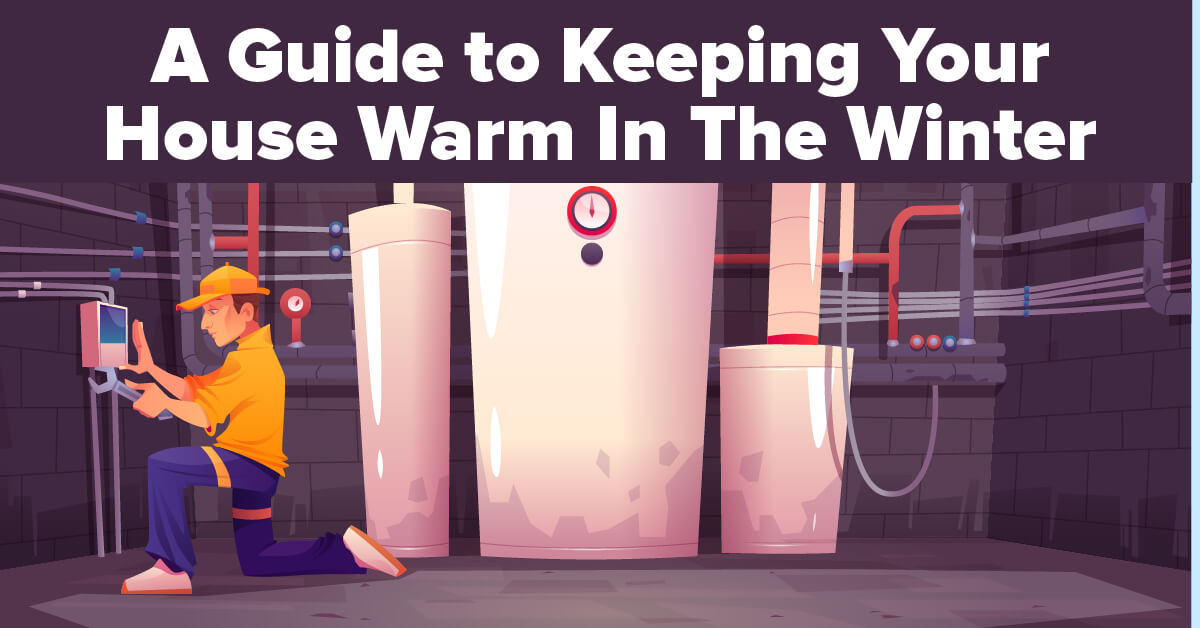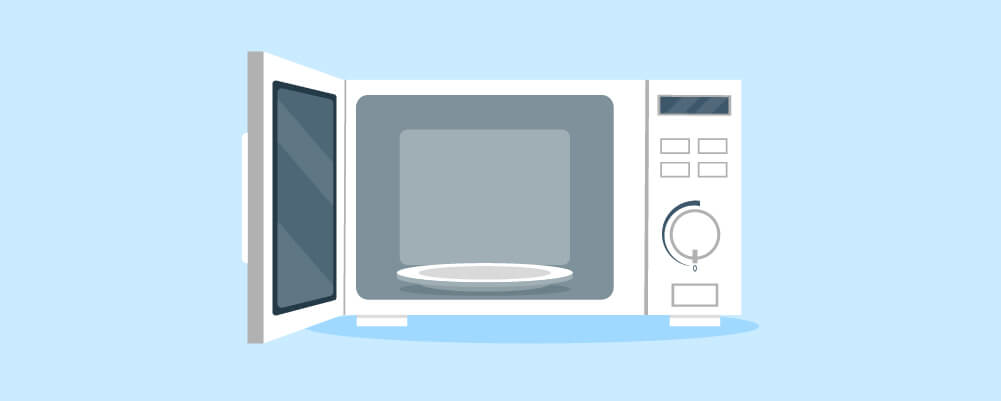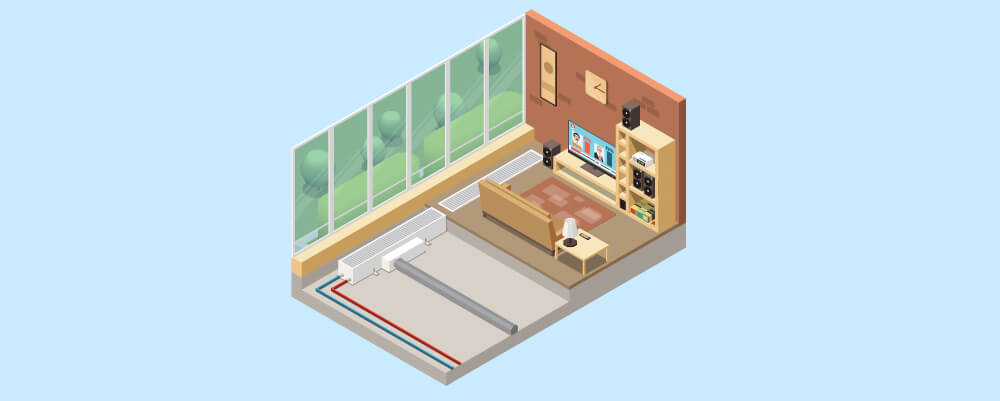How to Keep Your House Warm in the Winter (In-depth Guide)

If you’ve been searching for ways to keep your home warm this winter without burning out your power bill, this guide is for you.
No one wants their home to be cold in the winter months. However, the gas and electric prices have remained high so far in 2022, and for some of us, energy bills are not always easy to keep up with.
The good news is this: you don’t need to have every radiator in your home turned up on full blast to keep your home cosy.
There are plenty of economical ways to keep warm, from using your boiler efficiently to stopping heat from sneaking out through the home’s walls.

So, if you want to stay warm without worrying about the rising energy prices, read on: we have all the tips for you below.
Ideal Room Temperatures In Winter

The ideal ambient temperature setting for your home hovers between 18°C and 20°C. However, if you want to balance comfort, wellness, and efficiency, keeping your entire house at the same temperature is not the way to go. Each room has a specific temperature range that’s ideal for the activities in which you engage there.
For example, since we spend most of our time in the living room, it’s best to keep it at 20 °C to 22 °C — the most comfortable temperature for the widest range of people.
In contrast, our bedrooms should be a bit colder, in the 16 °C to 19 °C range, as we actually sleep better in cooler temperatures and have plenty of bedding to keep us warm.
Bathrooms should stay between 22 °C to 24 °C — nothing bites quite like a freezing toilet seat in the winter. However, be careful of a bathroom that is too humid, as excess moisture creates the perfect breeding environment for mould.
Kitchens are typically the hottest rooms in the house, so there’s no need to waste too much energy on heating them; a range of 18 °C to 20 °C should suffice.
Top Tips for Keeping Your House Warm In The Winter

So, we’ve established the ideal temperature benchmarks. Now, we’ll share some tips on how you can keep your home comfy and cosy in those cold winter months.
1. Ensure That Your Boiler Is Efficient And Regularly Serviced
Replacing an old boiler with a new, efficient model can have a tangible effect on your central heating system’s performance and energy consumption. Likewise, getting your boiler serviced annually will make sure that the appliance heats your home properly and lasts long.
If your boiler is not rated “A” — regardless of the rating system — you could be paying more to heat your home. For example, G-rated non-condensing boilers are often only 60-70% efficient, so for every pound you spend on natural gas, 30-40p are wasted.
Upgrading to an A-rated condensing boiler with an efficiency of 90%+ will mean that you worry less about turning up the thermostat on chilly days. According to the Energy Saving Trust, switching to an efficient boiler could actually save you up to £840 per year!
What’s more, modern condensing boilers are far more eco-friendly than their predecessors. Switching from an old G-rated non-condensing boiler to a new condensing model could save you money and reduce your CO2 emissions by 1,220 kg per year.
2. Install Draught-Proof Windows And Consider Double Or Triple Glazing
While you may not think so, closed windows are capable of letting heat escape, and draughts enter the house through a poorly-sealed window frame. This is why it’s always good practice to draught-proof your windows.
Here’s how you can do it.
Firstly, apply weatherstripping (sold at most home hardware shops) around the window, where the panes meet the frame.
Then, look for any cracks between the frame and the wall and seal them off with an appropriate sealant; again, your home hardware shop should have some options on offer.
Apart from having crevices that act as conduits for draughts, windows also give heat a simple path out of the home just because glass isn’t a great thermal barrier.
However, glass’s ability to block the movement of heat increases when you add an air gap and an additional pane of glazing. This is why double glazing is a more energy-efficient solution than single-pane glass.
So, if you feel that your home’s windows are letting heat escape, consider upgrading to double or even triple-pane windows. You’ll feel warmer with less output from your heating system, and your wallet will thank you in the long run as your heating bills decrease.
3. Insulate Your Loft

We often forget about that big room where we store all our Christmas decorations and random knick-knacks. However, if your loft is not insulated, you could be losing a good quarter of the heat your boiler generates.
Heat rises. As it emanates from your radiators, it gradually makes its way up to your ceiling and the loft. And, if the loft ceiling isn’t insulated, the heat can easily escape through the roof.
To make sure that your home can retain as much of the heat your boiler produces as possible, it’s wise to insulate hot air’s most leisurely, upward escape route. Check if your loft is insulated, and if it isn’t, try to get some quotes from insulation contractors in your area.
You may have to pay a bit upfront, but in the end, your home will stay warmer longer, and you’ll pay less for natural gas.
4. Insulate Your Doors
Here, we mean that you should insulate around the door, not the door itself.
Much like windows, the crevices between the door leaf and the frame can let through drafts allow heat to seep out. Even a 1-millimetre gap between your door and the frame could be letting out heat.
So, no matter if your doors are old or new, with lites or without, you should fit weatherstripping between the door and the frame.
At the base of the door, between the door and the threshold, you can also get a draft excluder to keep the heat in. Hinged flap draft excluders are exceptionally well suited for this job.
Not sure if your doors need weatherstripping?
A good door should fit snugly into its frame; if it opens too easily, chances are that it’s letting heat out. Put your hand up against the gap between the door and frame, and if you feel a slight draft coming in, you’ll need to seal it.
5. Draught-Proof Your Loft-Hatch
Insulating a loft can be costly, and you might not fancy investing that much money upfront. So, as a more economical alternative, you can choose to draft-proof the loft hatch instead.
To draught-proof the loft hatch, all you need is draught strips. Simply apply them around the hatch frame, and you should see instant results.
These inexpensive strips block the warm rising air from getting through the crevices around the hatch and help you conserve a good portion of the home’s heat. This is an excellent solution if you don’t have the budget for insulating the loft completely.
That said, you can still reap some benefits of draught-proofing the loft hatch even if your loft is fully insulated. After all, you probably don’t spend as much time up in the loft as you do, say, in the living room. So, there’s no point in letting all that warm air accumulate in a space you seldom utilise.
6. Draught-Proof Your Letter-Box/Cat Flap/Doggie Door
While letterboxes are useful for the postman, they’re also partly responsible for heat loss and draughts in your homes. And, unless you’re lucky enough to have your own letterbox outside of your home, most of us have these installed in our doors.
Now, if your letterbox has brushes in it, then it’s as draught-resistant as it’s going to get. Some may have a secondary flap, which also helps to block air movement between the indoors and the outdoors.
However, if your letterbox lacks these features, consider getting them installed. For a relatively small price, you could make sure that your front door doesn’t let any cold air in or warm air out.
Similarly, cat flaps and doggie doors can let out heat and allow cold air currents to get inside the home. If you’ve got one of these openings, make sure it has a draught excluder, which is essentially a brush that restricts air movement.
Also, note that some manufacturers offer draught-proof cat flaps that use the cat’s microchip to sense when the cat wants to come in, and keep the flap shut (and the cold air out) when the microchip is not nearby.
7. Seal off Your Chimney
Many homes in the UK still have a chimney, even if it is not being used to vent smoke from an active fireplace.
Now, you’ll agree that paying for triple glazing and insulating your loft is a huge waste of money if you have a chimney letting cold air in and hot air out all the same.
In fact, you can lose a good 4% of the heat in your home through the chimney alone, so if you’re not using it to vent the fireplace, you’ll want to seal it and keep the warm indoor air from escaping.
Believe it or not, a chimney balloon could save you as much as £200 in heating bills per year!
If you don’t use your chimney at all, you could get it professionally capped. However, if you do use it now and then, a draught excluder would be a more suitable option.
One of our favourites is the ‘Chimney Sheep’ — a thick layer of felted wool with a 4.43 tog rating, which can reduce the chimney airflow by a good 94%.
8. Upgrade Your Thermostat
Getting a modern thermostat can help you manage your central heating system with greater efficiency.
Firstly, a quality digital thermostat will allow you to set the desired temperature more accurately than its outdated, analogue counterpart.
Secondly, a smart, or programmable, thermostat will help you tailor the heating programme to your schedule. You’ll also get access to money-saving features, like the eco mode, geofencing, holiday mode, and more. All these handy functions serve one purpose — to minimise the fuel burnt whilst maximising your home comfort.
And as an added perk, most intelligent thermostats will let you control your heating inputs from a smartphone app.
9. Position Your Furniture Strategically
Would you believe that your furniture placement can have a massive impact on how heat gets distributed throughout your home?
We’re not talking about Feng Shui, of course. It’s relatively simple — if you have large cabinets, a sofa, or your bed up against a radiator, these items become an obstacle to heat. So, instead of propagating throughout the room, the heat will remain trapped behind the furniture.
Not only is this a terribly inefficient use of your boiler, but consistent exposure to the heat may end up damaging the adjacent furniture over time.
On the other hand, placing frequently used pieces of furniture near the radiators without blocking them will help you make the most of the heat the radiators produce.
Conversely, you should keep frequently used furniture away from draughty spots.
10. Repoint Ageing Brickwork And Masonry
Repointing means replacing the deteriorating grout from between masonry joints. If you’re not sure where your draught is coming from, it may be through a crack in the masonry joint.
You may not have heard of this before, but repointing is a necessary procedure for any ageing masonry structure. As the grout in the joints between brick or masonry units ages, it may develop cracks or become crumbly and create tiny openings in your home’s envelope.
To prevent draughts and heat loss, you have to repoint the brickwork once you can see that the grout has started to degrade. You can try doing this yourself, but it’s always best to ask for professional assistance — especially if you’d have to work at heights.
Additional Unexpected Ways To Stay Warm This Winter

The tips above have shown you some straightforward, obvious ways to keep warm in those chilly winter months.
However, we’re hardly done yet; there are plenty of other strategies you can use to keep your home toasty-warm in winter.
Now, some of these tricks may seem appealing if you want to reduce your reliance on radiators. That said, note that your central heating system is still your best friend at combating the cold during the most frigid times of the year.
1. Think about Getting Radiant Floor Heating
Radiant floor heating works by radiating heat from beneath the floor instead of radiators. It can be hydronic or electric; the former uses a network of pipes to circulate hot water, and the latter employs special cables that become hot when electricity passes through them.
This type of heating system is highly efficient for two key reasons:
- It takes advantage of the fact that heated air naturally rises.
- Subfloor heating systems give off heat beneath the footprint of an entire room, rather than from a relatively small area, like a radiator.
Thanks to these 2 advantages, radiant floor heating systems are efficient and comfortable, costing you less to operate and warming your living space much faster than radiators would.
Just like a typical central heating system with radiators and towel rails, radiant floor heating can work with a boiler.
And since the subfloor heating element covers such a large surface area, the circulating water needn’t be as hot as that flowing through radiators. This means that your boiler can be set to a lower temperature, which will help it to operate in the efficient, condensing mode and generate real cash savings on your heating bills.
These clever installations can be absolutely glorious in bathrooms, and this is usually the room where people install these heated floor systems. After all, nothing quite compares to stepping onto a toasty floor after getting out of a bath.
However, radiant floor systems can be installed literally in any room of the house.
While radiant floor systems do cost a fair amount of money to install, the long-term energy savings will help you offset some of the costs over time. If you’re thinking about installing such a system, it may be wise to wait until you’re performing major renovations in your home since you’ll have to rip off and reinstall the floors.
2. Get Some Rugs
If radiant floor heating sounds too expensive, or you don’t fancy ripping up your floor to have it fitted, you can go the simpler route and lay some rugs down on your floors.
Rugs have been used for thousands of years, and a good rug can really make a difference between a floor that’s unpleasantly cold and one that’s comfortable. This is especially true with hardwood or tiled floors, which tend to get quite cold in winter.
Wool rugs are your best option. Unlike synthetic materials, wool has stellar insulative properties and feels incredibly comfy underfoot.
That said, wool rugs may not be ideal if there’s moisture present in the home, as the latter may accumulate in the wool. If you suspect that a particular room of your home is more humid than others (a basement, for example), consider covering the floor there with a synthetic rug instead.
3. Apply Foil To The Wall Behind Your Radiators
If you can’t afford to insulate your home, the work seems like too much, or you don’t own the home, applying aluminium foil behind the radiators is a simple, inexpensive solution for conserving precious heat.
Poorly insulated walls give the heat a fast escape route from your house. A way to combat this is to use foil behind the radiators. This will reflect the heat from the radiator back into the room instead of allowing it to escape through the walls.
All you have to do is get some aluminium foil and tape it on the wall behind your radiators.
4. Stay Warm With A Hot Water Bottle
One of the easiest things you can do if you are feeling a bit chilly is to cuddle up with a hot water bottle.
Filling up a hot water bottle is much cheaper than cranking up your thermostat to full blast, but doing so can go a long way in taking away the chill.
Science tells us that we lose the most heat through our heads; however, our hands and feet also act as conduits for escaping body heat. This is why one of the best ways of staying warm is to wrap yourself up with a thick blanket and a hot water bottle at your feet. You’ll give your boiler (and heating bills) a break, all while staying warm and cosy.
5. Take Advantage of the Sunshine
UK winters may not be known for abundant sunshine, but on the rare sunny days, it (literally) pays to capitalise on the free solar energy.
Doing so is strikingly simple. All you need to do is operate your window coverings strategically by opening the curtains to let the sunshine in during the day and closing them around dusk to keep the heat inside.
This way, the solar energy will passively heat your home, even though it may not feel like it’s making a difference outdoors. If you have double glazing, you can expect the window to allow a good ¾ of the sun’s heat into your room. This technique can help you delay switching on your central heat.
One thing to note here is that not all windows excel at capturing this precious celestial heat. If your windows face South or West, you’ll get plenty of solar energy into your home, even on short winter days.
On the other hand, Northern orientation spells doom to your passive heating endeavours — all you’ll get is indirect light, which doesn’t do much in the way of space heating.
6. Keep the Oven Door Open After Baking

Here’s a nifty trick that’ll help you capture some waste heat that would otherwise be lost. After you’ve cooked that gorgeous Sunday roast, don’t close the oven door; keep it open and let the byproduct of your culinary efforts radiate out to your kitchen for as long as possible. This hack will work wonders if you’ve got a kitchen diner.
Note, however, that you should never leave the oven door open while it’s switched on. Doing so is extremely hazardous and could result in fires or even carbon monoxide poisoning.
Likewise, people who have pets or small children should probably avoid leaving the oven open to avoid potential injuries.
7. Use Bubble Wrap to Keep Heat In
This might seem a bit bizarre, but it’s been a home heating hack for a while now, so we looked into its validity. If upgrading your windows isn’t in the cards, applying simple old bubble wrap to the glass on chilly days is an effective, free alternative.
The air bubbles serve as insulating pockets, and can reduce heat loss through a single windowpane by roughly 50%. On double-glazed windows, this technique can cut heat loss by 20%, which is still quite a lot.
Of course, the major downside to this method is that sticking bubble wrap on your windows will obscure your views. But on the upside, water is all you need to get the wrap to stay on the window — no tape or adhesives required. This means that you can easily apply and remove the bubble wrap and store it for subsequent use.
It would seem that getting all that excess bubble wrap in your Amazon parcels can actually be useful!
8. Utilise Shower Steam
If you’ve ever jumped into a hot shower while you’re cold down to the bone, you’ll know how much heat that burst of hot water can generate. It takes mere minutes for your body to recover sufficient warmth.
Well, shower steam happens to be packed with heat, and leaving the bathroom door open during your ablutions can let this heat-laden steam circulate throughout your home.
Apart from injecting the home with warmth, shower steam will also add much-needed moisture to the dry, winter air. Which anyone with respiratory issues will certainly thank you for.
That being said, do be careful with steam, and try not to do this in excess. Steam is great for heat but also contributes to dampness.
9. Run Your Ceiling Fan In Reverse
Some of us may be lucky enough to have a ceiling fan in our homes. And while ceiling fans are a godsend in the summer, they can be fairly handy in winter, too.
Here’s why. When reversed, a ceiling fan rotates clockwise and draws the cool, dense air from the bottom portion of the room up while sending the warm air trapped around the ceiling down.
This way, the warmth generated by your central heating system is forced down to the part of the room that’s actually occupied; so, instead of heating the ceiling and light fixtures, you’re keeping yourself and your family warm.
10. Boil Some Water
The simplest tip to keep warm in the winter is to make yourself a nice, hot beverage. A cup of tea, coffee, or even a warm glass of milk will help keep you warm and cosy.
What’s more, the steam and heat generated when you boil the water will linger in the air, thus warming up the surroundings.
Why Is Cold Weather Bad For Your Health?

The brutal truth is that if our bodies are subjected to low ambient temperatures, our health actually does suffer for it.
Firstly, cold weather can place increased stress on our cardiovascular systems. This is because cold temperatures usually constrict our blood vessels, make our breathing shallow, and thicken our blood. For people who suffer from heart disease, a drop in indoor temperature can cause their condition to worsen.
What’s more, cold air can also affect those with asthma and other respiratory problems.
Cold air is typically dry, which is an issue for the human mucous membranes and the respiratory tract. For asthma sufferers, it causes the lungs to contract, thus making breathing difficult.
There’s a whole host of other problems we may experience if we encounter cold temperatures for an extended period. For example, our bodies must work harder to stay warm, making us tired and more susceptible to viruses and colds. That’s not to mention that cold, dry air is an ideal environment for respiratory viruses to spread.
Considering all the adverse health effects a cold environment can cause, it’s wise to know the optimal indoor temperature and ensure the mercury never falls below it in your home.
Summary

There are many ways in which you can keep yourself and your home warm in the winter without causing your energy bills to skyrocket. A lot of the tips above will help you recover waste heat from various processes at home, and block precious warmth from leaving the house.
So, check for draughts, grab a blanket, lay down a rug, and have a cuppa. You’ll feel toasty warm in no time at all without having to dial up the thermostat!
